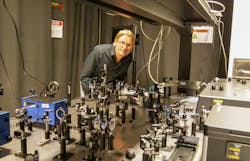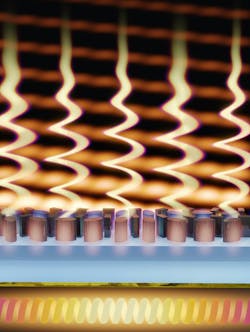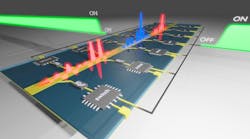‘Thermal metasurface’ controls optical properties of its own thermal radiation emission
What if metasurfaces—two-dimensional (2D) materials structured at the nanoscale—could control the optical properties of their own thermal radiation? Work by Andrea Alù, a distinguished professor at The City University of New York (CUNY) Graduate Center and founding director of the CUNY ASRC Photonics Initiative, and his team shows not only is it possible but it may enable custom light sources with extraordinary capabilities (see video).
They built upon their recent theoretical work, which showed a metasurface can be designed to shape its own thermal radiation to impart features such as defined frequencies, custom polarization, and a desired wavefront shape to create a hologram. Alù and his team predicted they could engineer a metasurface to produce and control its own thermal radiation—unlike conventional metasurfaces—in novel ways.
Being able to control thermal radiation, which is a form of electromagnetic waves emitted by heat-driven random fluctuations within matter, is highly desirable. While it’s inherently broadband, it’s also unpolarized and tends to spread out in all directions because of its random fluctuations with no spatial or temporal coherence—and this severely limits its use.
In their most recent work, the team experimentally validated their predictions via streamlining their device architecture to a single structured layer with a 2D pattern—with nanopillars arrayed across their surfaces. Varying the nanopillars enables control over light scattering to shape it in customizable ways.
“Metasurfaces have been explored for several years in a variety of contexts and offer great opportunities to manipulate the optical wavefront in a compact form,” says Alù. “But so far metasurface technology has been limited to manipulating coherent light, so it relies on external laser excitations that require bulky and costly sources.”
The team’s goal is a metasurface that doesn’t require external laser sources, “but provides precise control over the way its own thermal radiation is emitted and propagates,” says Adam Overvig, a former postdoctoral fellow in Alù’s group and currently an assistant professor at Stevens Institute of Technology.
Thermal metasurface design
The researchers’ new thermal metasurfaces are engineered to manipulate their own thermal emissions—despite its inherently coherent nature—with a degree of flexibility and control.
Conventional thermal radiation is unpolarized, so the team figured out how to make it circularly polarized—so its electric field oscillates. Their design enables asymmetric emission of circular polarization toward a single direction—and demonstrates full control over thermal emission.
“Rather than requiring an external source, our metasurface can just be heated up to produce the desired optical emission, controlling the spectral features, wavelength of emission, bandwidth, polarization state, and even its wavefront shape,” says Alù. “We’re very excited about this prospect, since it makes the metasurface a lot more amenable for broad use and integration.”
One noteworthy aspect of this work “is that the thermal metasurface doesn’t require sophisticated materials,” says Alù. “Our experimental demonstrations are based on a thin film of silicon structured with e-beam lithography.”
The team’s design exploits a combination of nonlocal interactions among the nanostructures patterned within the silicon film and local geometric rotations guided by symmetry rules that the team envisioned in earlier theoretical work.
Alù is thrilled about being able to shrink the metasurface platform by integrating the extremely cheap source—just its own heat—into the metasurface. “Added benefits are the simplicity and low cost of the platform, which is highly integrable in complementary metal-oxide semiconductor (CMOS) devices,” he says. “Another thing I’m excited about is that the same concepts apply to another form of incoherent light—photoluminescence, as the basis of light-emitting diodes (LEDs). So we expect these principles to apply also to ubiquitous LED technology.”
Their theory initially predicted two metasurfaces would need to be stacked atop each other, with precise alignment between them. “This makes fabrication very challenging,” says Alù. “But we were able to overcome this challenge, and our final design relies on a single thin film of silicon. This was a great breakthrough that enabled the experimental realization of this concept.”
Most surprising aspect of this work? “As common for research breakthroughs, I was excited to see the experiment at work,” Alù says. “While the theory predicted efficient emission, it’s always thrilling to see the experiment in action. Surprisingly, our metasurfaces can emit close to the fundamental limit of a blackbody—although a thin film of silicon emits very little when heated. The geometric patterning of nanostructures frees up the thermal energy to emit in the desired wavefront of choice.”
Thermal holograms ahead
As far as applications, the ability to create small, lightweight light sources with desired spectral, polarization, and spatial features is useful for scientists who need on-the-go light sources, such as for space-based technology, research in geology and biology, or military operations.
Beyond efficient lighting and imaging, these principles “offer new ways of controlling thermal emission for thermal management and camouflaging,” Alù says. “Extending it to LED technologies is also very exciting, given the ubiquity and low cost of both thermal and LED sources.”
“We’re exploring new designs that can produce even more sophisticated optical wavefronts,” says Alù. “Our goal is to demonstrate a ‘thermal hologram,’ which is a thermal metasurface that produces a holographic image of choice with defined structure, color, and polarization when heated up.”
FURTHER READING
J. R. Nolen, A. C. Overvig, M. Cotrufo, and A. Alù, Nat. Nanotechnol. (2024); https://doi.org/10.1038/s41565-024-01763-6.
Related Articles
About the Author
Sally Cole Johnson
Editor in Chief
Sally Cole Johnson, Laser Focus World’s editor in chief, is a science and technology journalist who specializes in physics and semiconductors.





